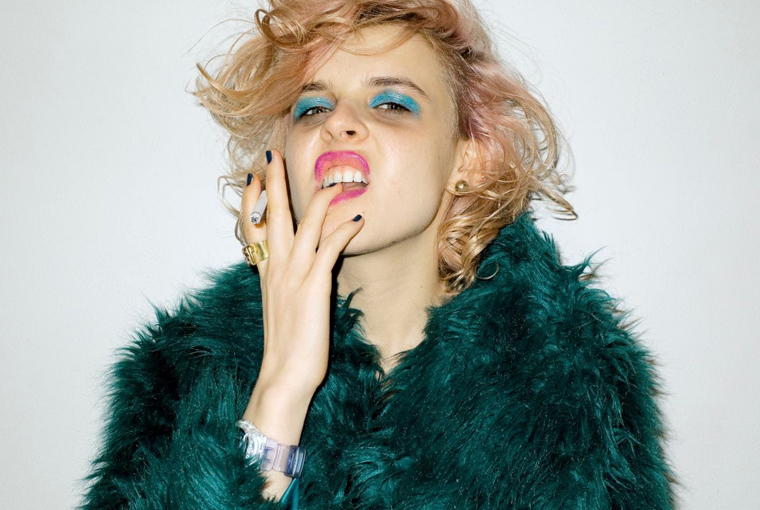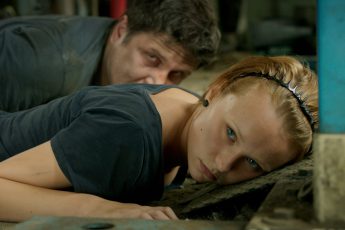"It’s Like You Have This Subconscious Pleasure of Dying."
Kasia Rosłaniec’s Satan Said Dance (Szatan kazał tańczyć, 2016)
Vol. 80 (December 2017) by Jack Page
Comprised of fifty-four sequences, all of them two minutes in length, Satan Said Dance details riotous episodes in the life of newly successful author Karolina. Karolina’s daily routine is structured entirely around her appetite for sex and drugs as she struggles to navigate her way from youth to adulthood. It is not long, however, before her chaotic lifestyle unveils more troublesome woes. It becomes abundantly clear to Karolina that her scandalous exploits may have lasting effects after all.
It would be dismissive to say that Satan Said Dance in any way glorifies Karolina’s lifestyle choices. In some instances, the film’s artistic flare runs the risk of disparaging the character’s integrity in favor of flashy imagery. Nevertheless, Karolina’s escapades are purposefully foregrounded in order to express an inherent sense of nihilism. The consequences of her excessive consumption are agonizingly clear in the cold light of day. As her own worst enemy, Karolina’s suffering envelops her like a relentless hangover that knows no cure. Her bulimia leaves her locked in the bathroom as she dry heaves and gags on her own two fingers after gulping spoonfuls of peanut butter. Her alcohol abuse leads her to passing out drunk. Every high she reaches with recreational drugs is met with an even harder comedown that sends Karolina to the brink of a mental breakdown. Her forever unfulfilled sexual appetite causes all her close male relationships to self-implode until she is left behind by everyone. At one point, one of her many lovers asks why she acts this way, to which she coquettishly replies: “I guess I’m just greedy”. She may not be a shameful or regretful person but her life is by no means appealing to the viewers who bare witness to the damaging impact of Karolina’s live fast and die young ideals. She is aware of her destructive tendency and yet continues on her path of self-harm.
The final sequence of the film perfectly embodies this tenet. At a rave in a local nightclub, Karolina dances wildly in the middle of a crowd. Neon colors and strobe lights flash feverishly over her sweaty silhouette as she writhes rhythmically to the thumping of the techno soundtrack. An old boyfriend saunters up behind her, mirroring her frantic twists and turns. He offers her cocaine directly from a small cellophane bag before going to the bar to buy her a drink. Upon return he hands her a cocktail glass that, as she sips, fractures and shatters in her mouth. She panics, spitting out pieces of broken glass onto the dance floor. After narrowly escaping what could have been a serious injury, she shrugs off the incident and continues jumping to the beat. Though Karolina is visibly relieved, the long take reveals that a pained expression is noticeably etched into her face. Her eyes bulge with hedonistic glee. Her profile becomes a crooked grimace that alters between smile and frown. It is here, in the limbo between pleasure and pain and heaven and hell that she is doomed to exist.
Karolina’s fears stem from a lack of permanence and the impossibility of control. For example, she is scared of losing her inspiration, of falling out of fashion and of losing her dwindling sense of celebrity. Even her underlying heart condition may be a more heavy-handed symbol for these kinds of deterioration. Like the pleasures in her life, the qualities that make Karolina special – her looks, her mind – are also susceptible to change. A sympathetic spectator might argue that her zealous pursuit of sex and drugs is an attempt to forget or at least avoid this rather sobering realization.
The most interesting and complex issue of Rosłaniec’s feature is her exploration of the dangers of social media and, more specifically, the cannibalistic nature of “selfie” culture. The film utilizes a 1:1 aspect ratio, mirroring that of the square framed formatting akin to a phone camera. Consequently, the film introduces the presence of social media culture through its very aesthetic. In Satan Said Dance, social media are revealed to be as addictive and harmful as any other of Karolina’s more illegal and controversial vices. They construct an exploitative downward spiral which shapes nearly every aspect of her life. For Karolina, everywhere and anywhere is a photo shoot. She waltzes down the streets of Warsaw in her hipster outfit as if she were filming a music video. Although fashionable, her look screams out for attention. She wears a leopard skin print fur coat, dyes her hair bubblegum pink and applies heavy eyeliner makeup. Ironically, she resembles the china doll in her book, hinting at the hidden fragility of her personality. She may look tough, but she is easily breakable.
Karolina’s striking style is difficult to sustain, however. Her obsession with self-image gives way to a nagging self-doubt and gross self-hatred that soon begins to consume her. At one point, on her laptop, Karolina takes a stream of self-portraits only moments apart. A vast number of digital photos engulf the screen, every one expressing a distinctly separate emotion. In this instance, the filmmaker employs the “selfie” as a visual manifestation of Karolina’s fragmented psyche. Each picture represents the different faces she wears and the different personalities she performs. Even Karolina herself can no longer recognize her true self, failing to distinguish which versions of her are real and which are fake.
Ultimately, Satan Said Dance is both an unflattering vision of today’s youth and a condemnation of social media practices. With the addition of female sexuality, Rosłaniec’s film seamlessly entwines these ideologies into a daring and pseudo-experimental experience. At the heart of it all, however, is the misguided attempt of a young woman who – by trying to resist time’s pull of death and decay – is drawn ever closer to her own demise.




Leave a Comment